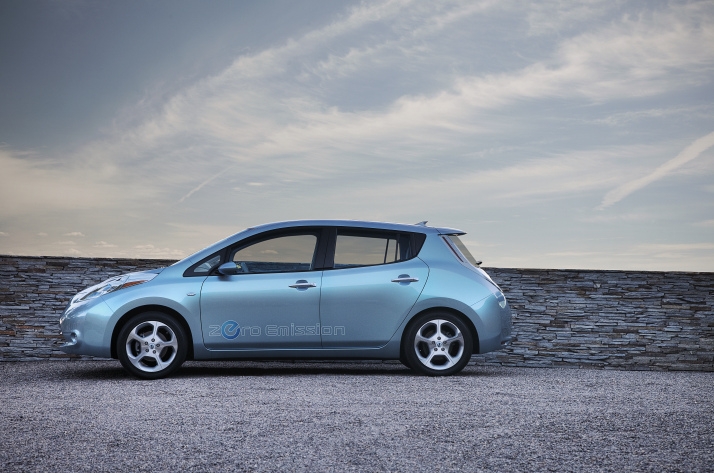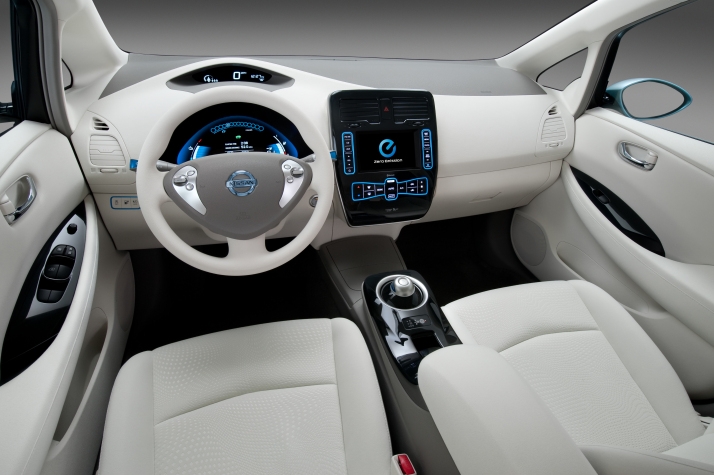2011 Nissan Leaf: First Drive
By Alison Lakin, Associate Editor
Many consumers imagine an electric car to be a little, well, different, and to some degree they’d be right; inside and out, everything on the Leaf is slightly futuristic. Even turning the car on is something special. Nissan’s engineers found that many hybrid owners wanted a more obvious notification than a ‘Ready’ light on the dash to alert them that the car was on, so pressing the start button generates a wave of pleasant chimes that echo through the cabin as the colorful digital dash fires up, much like booting up a computer.
Putting the car into drive presents another learning experience, with the ‘gear’ selector being a donut-sized knob on the center console with a P button for park in the center. Sliding it left and up puts the car into reverse and moving it straight across puts it in neutral. Sliding it left and down shifts the Leaf into drive and if you do it a second time the car goes into Eco mode, which allows the car to conserve electricity by reducing the amount of power expended when accelerating and increasing the influence of the regenerative brakes. It’s not a particularly fun mode, but it’s easy to see how can conserve juice when stuck in traffic. The Leaf will pop back into normal drive mode temporarily should you need more passing power.
Nissan was adamant that the Leaf should drive like a normal five-seat sedan – despite its complete lack of engine noise and futuristic styling cues – and it seems to do exactly that. Acceleration isn’t blisteringly fast with the 80 kW motor and 24 kWh lithium-ion battery propelling the car steadily up to speed, but stepping on the accelerator pedal generates a good amount of thrust, convincing us of the claimed 90 mph top speed. Speed-sensitive steering is similar to all cars with electric power assist steering in that it feels slightly disconnected, but it’s still responsive and well weighted, and the regenerative braking system that returns power to the battery as the car slows still lacks the smooth brake pedal travel; it feels odd and a bit too firm at times, similar to others on the market.
What is most striking about the drive is the Leaf’s sound level, or lack thereof. Stripped of a mechanical engine, the car is eerily quiet. So quiet in fact, that Nissan took extra steps in reducing noise from the tires by adding low rolling resistance rubber and muffling the windshield wiper motor because their sounds were unexpectedly conspicuous. The Leaf does emit a high-frequency noise from an exterior speaker up to 18 mph for the benefit of the sight-impaired, though it’s impossible to hear it from inside the cabin.
Much like the Toyota Prius, the Leaf’s odd body design helps with aerodynamics – as does a sealed undercarriage and functional rear spoiler – which is an important factor in maintaining the maximum 100-mile range. And those googly-eyed headlamps do have a very specific purpose: they split the airflow around the wing mirrors to reduce wind buffeting.
So the Leaf delivers a fairly normal drive experience with a few special features, but amazing car technology is pretty useless without a livable cabin space and the long list of standard amenities we now expect in a car. Good thing the Leaf’s interior is actually quite impressive. It’s no luxury car, but all five seats are comfortable – those in the rear have plenty of headroom – and from the front two you have a clear view of the good-looking instrument panel and touch-screen center display unique to the Leaf. Within the large screen are settings functions, navigation, audio controls and a battery monitoring system that displays battery usage and battery life as well as charging status.
Standard on all Leaf models are a six-speaker audio system, Bluetooth connectivity, USB and auxiliary jacks, push button start and a full flash drive-based navigation system, which will be regularly updated with nearby charging stations for your longer drives. Those who opt for the SL trim will also get a backup camera and a solar panel on the rear spoiler – it’s clearly more about marketing than function, but it does run a few auxiliary electronics. A cold weather package will add a temperature management system and heated steering wheel, mirror and seats.
The Leaf can achieve a claimed 100-mile range on a single charge, and power is supplied via a universal plug (all manufacturers will use one design) by three types of chargers: the first is a regular 110/120-volt household plug that will provide what Nissan calls a ‘trickle charge’ because of its 20-hour charge time. The more common option will be a 220/240-volt charging station that can be installed in your home for a seven- to eight-hour charge time. The setup will cost $2,200, with half of that price being covered by the government. The last is a commercial DC fast charger that will give you 80 miles of charge in just 30 minutes, a time that may just revolutionize the EV market and eliminate ‘range anxiety.’
The most recent count puts Leaf orders at over 16,000 units already. To be fair, the $32,780 MSRP seems steep until you take into account the $7,500 tax credit that Nissan plans to roll into its leasing arrangement so buyers can maximize savings instantly. With its list of standard features and surprisingly normal drive experience, the Leaf – electric car or not – suddenly becomes a shockingly (!) good deal for just $25,280.
Slated for release in December, the Leaf will be available to residents of five states (California, Washington, Oregon, Arizona and Tennessee) at first, followed by a rolling nationwide release throughout 2011.
|
|
Track Your Service Records
Get Recall Alerts
Get Updated Value Estimates on Your Car.
Go to a Review
Similar Articles
Popular Car Articles
Latest Car Reviews
Auto Tools
Local Guides
All Guides
Alabama
Alaska
Arizona
Arkansas
California
Colorado
Connecticut
DC
Delaware
Florida
Georgia
Hawaii
Idaho
Illinois
Indiana
Iowa
Kansas
Kentucky
Louisiana
Maine
Maryland
Massachusetts
Michigan
Minnesota
Mississippi
Missouri
Montana
Nebraska
Nevada
New Hampshire
New Jersey
New Mexico
New York
North Carolina
North Dakota
Ohio
Oklahoma
Oregon
Pennsylvania
Rhode Island
South Carolina
South Dakota
Tennessee
Texas
Utah
Vermont
Virginia
Washington
West Virginia
Wisconsin
Wyoming
Alabama
Alaska
Arizona
Arkansas
California
Colorado
Connecticut
DC
Delaware
Florida
Georgia
Hawaii
Idaho
Illinois
Indiana
Iowa
Kansas
Kentucky
Louisiana
Maine
Maryland
Massachusetts
Michigan
Minnesota
Mississippi
Missouri
Montana
Nebraska
Nevada
New Hampshire
New Jersey
New Mexico
New York
North Carolina
North Dakota
Ohio
Oklahoma
Oregon
Pennsylvania
Rhode Island
South Carolina
South Dakota
Tennessee
Texas
Utah
Vermont
Virginia
Washington
West Virginia
Wisconsin
Wyoming













